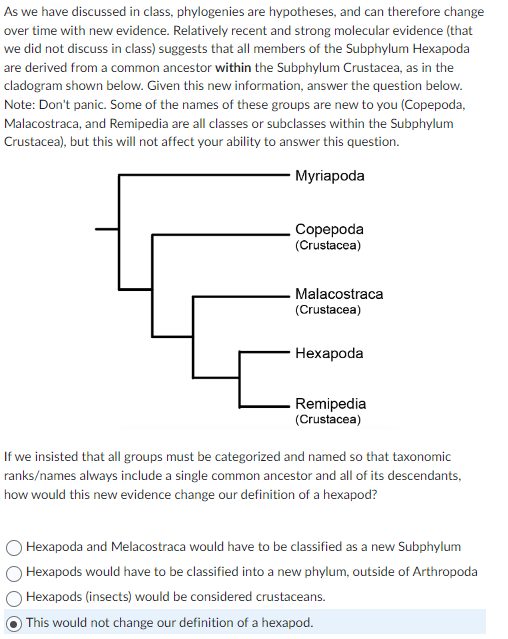If we insisted that all groups must be categorized and named so that taxonomic ranks/names always include a single common ancestor and all of its descendants, how would this new evidence change our definition of a hexapod? Hexapoda and Melacostraca would have to be classified as a new Subphylum Hexapods would have to be classified into a new phylum, outside of Arthropoda Hexapods (insects) would be considered crustaceans. This would not change our definition of a hexapod.
If we insisted that all groups must be categorized and named so that taxonomic ranks/names always include a single common ancestor and all of its descendants, how would this new evidence change our definition of a hexapod? Hexapoda and Melacostraca would have to be classified as a new Subphylum Hexapods would have to be classified into a new phylum, outside of Arthropoda Hexapods (insects) would be considered crustaceans. This would not change our definition of a hexapod.
Biology Today and Tomorrow without Physiology (MindTap Course List)
5th Edition
ISBN:9781305117396
Author:Cecie Starr, Christine Evers, Lisa Starr
Publisher:Cecie Starr, Christine Evers, Lisa Starr
Chapter11: Evidence Of Evolution
Section: Chapter Questions
Problem 1CT
Related questions
Question

Transcribed Image Text:As we have discussed in class, phylogenies are hypotheses, and can therefore change
over time with new evidence. Relatively recent and strong molecular evidence (that
we did not discuss in class) suggests that all members of the Subphylum Hexapoda
are derived from a common ancestor within the Subphylum Crustacea, as in the
cladogram shown below. Given this new information, answer the question below.
Note: Don't panic. Some of the names of these groups are new to you (Copepoda,
Malacostraca, and Remipedia are all classes or subclasses within the Subphylum
Crustacea), but this will not affect your ability to answer this question.
Myriapoda
Copepoda
(Crustacea)
Malacostraca
(Crustacea)
Hexapoda
Remipedia
(Crustacea)
If we insisted that all groups must be categorized and named so that taxonomic
ranks/names always include a single common ancestor and all of its descendants,
how would this new evidence change our definition of a hexapod?
Hexapoda and Melacostraca would have to be classified as a new Subphylum
Hexapods would have to be classified into a new phylum, outside of Arthropoda
Hexapods (insects) would be considered crustaceans.
This would not change our definition of a hexapod.
Expert Solution
This question has been solved!
Explore an expertly crafted, step-by-step solution for a thorough understanding of key concepts.
Step by step
Solved in 3 steps

Knowledge Booster
Learn more about
Need a deep-dive on the concept behind this application? Look no further. Learn more about this topic, biology and related others by exploring similar questions and additional content below.Recommended textbooks for you

Biology Today and Tomorrow without Physiology (Mi…
Biology
ISBN:
9781305117396
Author:
Cecie Starr, Christine Evers, Lisa Starr
Publisher:
Cengage Learning

Biology Today and Tomorrow without Physiology (Mi…
Biology
ISBN:
9781305117396
Author:
Cecie Starr, Christine Evers, Lisa Starr
Publisher:
Cengage Learning